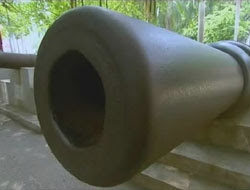The destruction of opium in Humen was a significant event in Chinese history. The protagonist of this event was the Chinese national hero Lin Zexu. The time-honored gun batteries bear witness to the flames of war. The material exhibits reveal the evil of the opium trade.


An official loyal to the Qing court, Lin Zexu was most famous as a national hero for his active fight against foreign-imported opium during the Qing Dynasty. Although he did not want a war between China and Great Britain, his aggressive anti-opium policies are usually considered to be the primary catalyst for the First Opium War, forcing China into signing the unequal treaties.


Lin was born on August 30, 1785 in Fuzhou, Fujian Province. Until he was 17 years old, he assisted his father as a maker of artificial flowers. Aided by a wealthy friend, whose daughter he married, he became a student, successfully passed the different examinations and received the highest degree in 1811. He rose rapidly through various grades of provincial service, and became Governor of Hunan and Hubei provinces in 1837. He had successfully stopped opium consumption in an inland province and suggested to the emperor ways to suppress the opium trade.
As a formidable bureaucrat known for his thoroughness and integrity, he was appointed as an imperial commissioner and sent to Guangzhou to halt the importation of opium by the British prior to the First Opium War in 1838. He fought against what he saw as the pernicious evil of the opium trade, and the shameless way in which foreign opium merchants regularly flouted edicts banning opium. He particularly despised the officials that cooperated secretly with these merchants for their own private gain. He confiscated more than 20,000 chests of opium already at the port and supervised their destruction. He later blockaded the port from European ships. He also wrote a letter of understanding, of a type known as a memorial to Queen Victoria of Britain, warning her that China was adopting a stricter policy towards everyone, Chinese or foreign, who brought opium into China.
 Located in Humen Town in Dongguan, the Opium War Museum is where the historical materials and the relics of Lin Zexu destroying opium and the Opium Wars (1840-1842 and 1856-1860) are preserved, exhibited and researched. Lin (1785-1850) was a great patriotic politician and poet in Qing Dynasty (1644-1911). He destroyed about 1,188,127 kilograms (2,619,372 pounds) of opium at Humen Beach in 1839. The museum is a National AAAA Tourist Attraction as well as one of the one hundred National Patriotism Education Base Models. The Opium War Museum comprises three scenic areas: the museum itself; the Shajiao Emplacement; the Weiyuan Emplacement. The museum is also called Humen Lin Zexu Memorial Hall. Shajiao and Weiyuan Emplacements are situated in Shajiao Community and Weiyuan Island in Humen.
Located in Humen Town in Dongguan, the Opium War Museum is where the historical materials and the relics of Lin Zexu destroying opium and the Opium Wars (1840-1842 and 1856-1860) are preserved, exhibited and researched. Lin (1785-1850) was a great patriotic politician and poet in Qing Dynasty (1644-1911). He destroyed about 1,188,127 kilograms (2,619,372 pounds) of opium at Humen Beach in 1839. The museum is a National AAAA Tourist Attraction as well as one of the one hundred National Patriotism Education Base Models. The Opium War Museum comprises three scenic areas: the museum itself; the Shajiao Emplacement; the Weiyuan Emplacement. The museum is also called Humen Lin Zexu Memorial Hall. Shajiao and Weiyuan Emplacements are situated in Shajiao Community and Weiyuan Island in Humen. 

Humen Bridge, with a length of 17.76 kilometers, is one of the longest suspension bridge in China. Its main span is 888 meters in length. It is not only a substantial part of the expressway net in the Pearl River Delta area, but also a landmark tourist destination in Dongguan.
虎门大桥飞架珠江口,连接虎门、番禺两地,是我国第一座大型悬索桥,1997年6月建成通车,主航道跨经888米,总投资近29.4亿元。虎门大桥全长15.76公里,主桥长4.58公里,桥面双向六车道,设计昼夜通车量为12万车次。每根主缆由13970根直经为5.2毫米的镀锌高强钢丝组成,主缆长16.4公里。大桥辅航道桥是270米连续钢结构桥;主跨净空高60米,桥下可通航10万吨巨轮。

没有评论:
发表评论